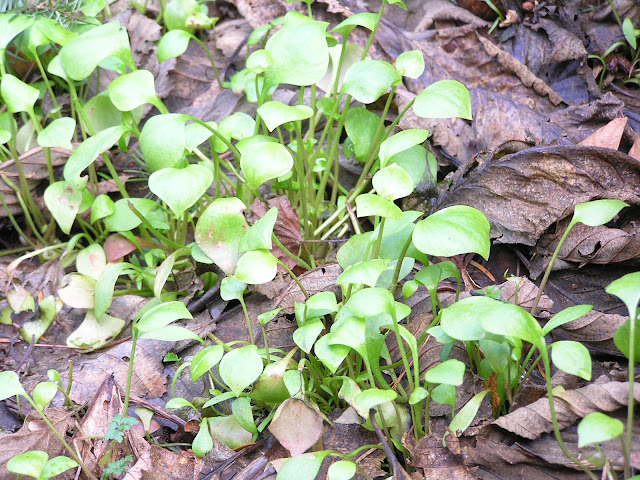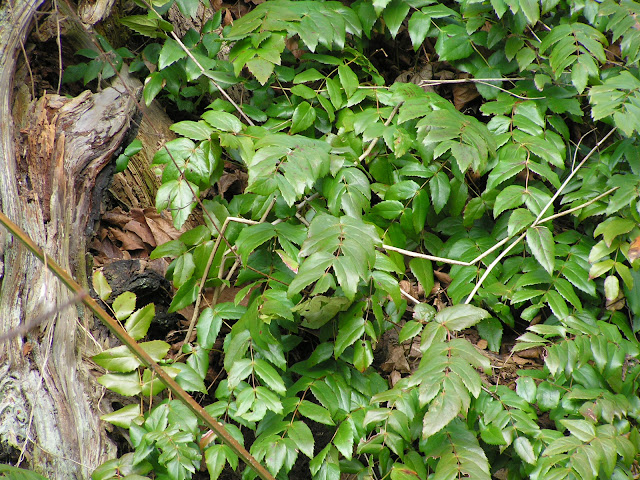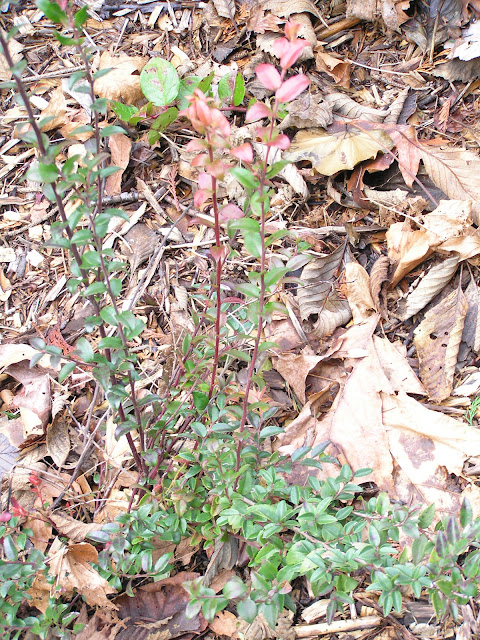How To Find Edible Weeds
Foraging
Health
Paleo
Raw
Remedies
Unschooling
Urban Farming
I've been very inspired by a friend of mine who teaches classes on wild foraging. I learned that so many of the common plants growing freely in my own yard are not only edible, but delicious, and there is a whole world of edible plants available for free at our local parks and beaches. Melany's classes focus on the edibility of invasive plants. Although many native plants are also edible, it actually benefits our local ecosystem to harvest invasives.
Personally, her classes have given me a new perspective on my own yard. Weeds become a different entity when you consider how nutritious they are! Check out her blog for more info. Here's what we saw today:
 |
| Bedstraw or Cleaver (Galleum). While it has velcro-like leaves and stems that stick to each other and to clothing, the young leaves & stems are surprisingly tender and can be eaten fresh or used in salads. |
|
 |
| Catsear (Hypochaeris radicata). This is a particularly ugly example. You wouldn't want to harvest it, as it's obviously been stepped on. Better examples are most likely all around you! They are similar looking to dandelion greens, only very fuzzy and less bitter. Add young leaves to salads, or roast & brew the root for a coffee-like drink. |
 |
| Chickweed (Stellaria). Entire plant is edible raw in early spring. Very tender and mild. |
 |
| Nipplewort (Lapsana communis). Edible flowers and young leaves. |
 |
| Horsetail (Equisetum). This time of year the inedible dead stalks are still standing from last year. Soon though, new asparagus-like shoots will grow in this marshy woodland, and can be eaten raw or sauteed. Peel off outer layer of young shoots to expose the tender middle. |
 |
| Miner's Lettuce (Claytonia perfoliata). Tender and delicious; leaves, stems, and the tiny white flowers that will soon bloom are edible. |
 |
| Nettles (Urtica dioica). While this is a great time of year to harvest tender, nutritious young nettles, this particular area had kind of shoddy looking plants. To me the leaves look like serrated hearts. The underside and the stems are covered with stingers, but you can pick a leaf with bare hands, fold it carefully, and chew it up. Fresh nettles taste really good! They can also be blended thoroughly in green smoothies, or cooked in any way you might cook spinach. |
 |
| Oregon Grape (Mahonia aquifolium). New leaves in spring, which are a lighter green, are tender enough for salads. Dark blue berries can be used for jams or wines at the end of summer. This plant is native to the Pacific Northwest, so is not really a weed. |
 |
| Salal (Gualtheria shallon). Another PNW native shrub, but a useful plant to know about. The dark blue berries were described as "better than blackberries," so I can't wait to try them! Fruits in late summer. Tender young spring leaves are edible as well. |
 |
| Shotweed (Cardamine hirsuta). So-called because the seeds shoot off of it all over your garden when you come near it. However, the leaves are very tasty, with a slight peppery tinge. Similar in taste to nasturtium leaves, but milder. |
 |
| Sword Fern (Polystichum munitum). It was determined that ferns should be avoided since the young shoots are carcinogenic. I had heard that fiddlehead ferns are quite tasty sauteed, but they should be considered a novelty food. I included it here just so I can remember what this type of fern is called ;) |
 |
| Wall Lettuce (Mycelis muralis). A bitter green, but that's what salad dressings are for! |
 |
| Water Hemlock (Cicuta). Poisonous, absolutely deadly. This plant has similar characteristics to the wild carrot, so both should be avoided until you learn to distinguish them carefully. Don't even touch it. |
 |
| Wild Huckleberry (Ericaceae). Another native that we should be very careful with, an important plant for native wildlife. |
 |
| Yellow Dock (Rumex crispus). Use leaves, after removing the tough midrib, for dolmas or green smoothies. Tiny seeds are edible but hard to remove from their sheathes. Chew up a leaf and apply leaf paste to sooth a nettle sting. |
Other plants we discussed include the Chinese Coin plant (Lunaria annua) also called Annual Honesty plants because of the translucent seed pods that hide nothing. These weedy plants have gorgeous purple flowers and striking purple seed pods that turn papery when mature. The seed pods are edible when immature, leaves and roots may be edible as well.
Blackberry (Rubus) obviously has edible berries, but the young leaves can also be eaten. I know raspberry leaves make a tasty, nourishing tea and now I want to try making tea with blackberry leaves. Any plant in the rose family has edible leaves, flowers, and fruit.
Indian plum (Oemleria cerasiformis) is another PNW native, and the "harbinger of spring" as its leaves are a sign that spring is here. The white flower cluster looks like a face with two leaves that stick up like floppy rabbit ears. The young leaves are tasty, and the plums are somewhat edible. They have a large pit and are mealy.
Large Leaf Maple (Acer macrophyllum) has edible young flower clusters. They can be stir fried in butter in early spring. It's native also.
Rose (Rosaceae rosa) has edible young leaves, petals, and rosehips. Gather rosehips in fall and press through a sieve with the back of a spoon to remove seeds. Mix with honey for a simple, tasty syrup rich in vitamin C.
Mountain Ash Berry (Rosaceae sorbus) also called the Rowan tree, produces large clusters of bright orange/red berries that can be used for jam or wine.
Hawthorne (Crataegus monogyna) has edible leaves but the pomes, like tiny apples, are mealy.
Skunk Cabbage (Lysichiton americanus) has been used for food in times of starvation, but has very unpleasant, possibly dangerous effects, when consumed due to the formation of oxalic crystals that cut the mouth. Bears use the roots for food in winter, and the plant has medicinal uses.
Snow Berries (Symphoricarpos) have edible, though not sweet, white berries in winter.
Japanese Knotweed (Fallopia japonica) is highly invasive and damaging to salmon habitat. Young asparagus-like reddish shoots can be eaten in spring. Peel outside layer to expose tender middle. Look for shoots near mature knotweed, also called false bamboo because it looks similar to bamboo but is weak and breaks easily.
Douglas Fir (Pseudotsuga menziesii) has soft green tips that can be eaten in June, along with hemlock, pine, and spruce. A delicious tea can be made from the tips of most evergreen trees, but it sounds like Doug Fir is particularly delicious. Someone mentioned making ice cream from it. It has a sweet, lemony flavor. Also the cones from any trees have edible seeds inside, but most are so small they aren't worth harvesting unless you're a squirrel. However, Monkey Tail Trees (Araucaria araucana) have incredibly huge nuts that are similar to pine nuts, though more fibrous and the size of almonds.
Red Flowering Currant (Ribes sanguineum) has edible everything (of course, since it's in the rose family)
This is just the beginning! If you're interested in learning more about this, please also check out my post Wild Foraging in April.
Below are Amazon Affiliate Ads. Any purchase made through them helps support our family. Thanks in advance!
Share the article to support the site!
How To Find Edible Weeds
4/
5
Oleh
Mellow
Subscribe via email
Get up to date articles the second they come out!





















46 comments
Write commentsGreat piece Mellow! Once just needs to watch out for heavy metal contamination in urban areas :( Especially with greens and roots, from what I've read, it seems fruits are less likely to uptake heavy metals. Part of my own yard has high lead, chromium, arsenic, aluminum and beryllium. I recommend soil testing and blood monitoring.
ReplyOur cousin taught us to make "sweet water" (which he learned about from a Native American friend, I believe): just pick a handful of those really bright green Douglas Fir tips when they are young and tender, add them to a jug of water and let it sit overnight. You'll end up with a sweet and refreshing drink -- it's really lovely, especially chilled!
ReplyKat, someone mentioned that during our class as well! I will definitely try it in a few months.
ReplyLove foraging. I need to take this class!
ReplyWhat an informative post--thank you for sharing, because I learned a lot! I grow oregon grape in my garden, just as a pretty garden plant, but had never eaten the berries before.
ReplyReally nice post! I've shared it on my fb page: https://www.facebook.com/pages/Learning-and-Yearning/229256057187940
ReplyWe have many of the plants in our area - but I think I'll stick to buying from the Farmers' Market!
ReplyWhat a great resource for these weeds/plants and photos! You've always got such interesting stuff to share with us at the TGP!
ReplyThanks Jami!
ReplyWow! I would love to go foraging, but pretty much all the land in my area is developed, and any weeds are sprayed with chemicals. Sigh.
ReplyThat's sad! We find many of edible weeds in our own small yard. Are there no unsprayed parks in your area?
ReplyThanks for sharing!! I am going to a class soon that will be on edible wild fall plants. I'm excited, as I've seen berries and such nearby and don't know if they're safe or not!
Replyhttp://www.munchtalk.net
Great post. I wrote a similar post about weeds edible for our chickens, I might have to try some myself! I hope you'll come link up at our Blog Fest: http://fresh-eggs-daily.blogspot.com/2012/09/farm-girl-friday-blog-fest-1.html
ReplyThanks Lisa, I'll check it out!
ReplyOh I must say this is a fascinating post. I have always looked for edible weeds and have a few books but honestly have second guessed some of my guessing it is right skills.
ReplyI am going over to check out her blog. Thank you. B
Thank you for sharing, I must say, I really didn't even know 10% of what you shared! And thank you so much for linking up with Healthy 2day Wednesdays as always! Hope you have a blessed week and hope you'll be linking up this week! I also wanted to let you know we are looking for another person to co-host H2W's with us if you are interested! :)
ReplyThanks Rachel! What would co-hosting involve? I'm interested!
ReplyWe go on a weekly rotation of who "hosts". The host (the person who chose the top 3 that week) is responsible of commenting on the posts who linked up, invite people to link up, share their top 3 in social media/pinterest and then host H2W each week as well, but don't have to do the "work" until it's your turn... hope I made that make sense, lol! If you are interested, just email me! :)
ReplyWow - great information! A lot of those grow around here but other than morels, ramps, blackberries and asparagus, we haven't branched out into identifying other edible plants.
ReplyWow, interesting! I'd love to forage for edible weeds on our property. We did find some puffball mushrooms last year and cooked them up. It's so nice to find free food haha.
ReplyVisiting from Hearth & Soul :)
Thanks! I have two other articles on common edible weeds:
Replyhttp://alifeunprocessed.blogspot.com/2012/06/identifying-and-harvesting-weeds-in.html
http://alifeunprocessed.blogspot.com/2012/04/wild-foraging-in-april.html
I just pinned this! I am telling my husband for years, that you can eat some of those, and he never believed me! Guess who just got a email with your post :)
ReplyThank you so much for sharing this at Wednesday Extravaganza! Hope to see you there again this week :)
This time of year we're just getting some fresh greens popping up again. It may be a good time to try some!
ReplyWhat a neat way to get some extra greens into your diet ;) Thanks so much for sharing this on Waste Not Want Not! I'm tweeting and pinning it!
ReplyWhat an inspiring post! I want to take your friend's class!! Thanks for sharing your knowledge with us at Raw Foods Thursdays. Have a great weekend!!
ReplyI found you at Frugally Sustainable. What an excellent article! Having the photos makes a huge different and makes it seem much more accessible to newbies at foraging like me. Thank you so much! :)
ReplyNatalia
http://preputilityvehicle.blogspot.ca/
Thank you, I'm so glad it helps! Happy foraging!
ReplyYeah, I learn something new every time I talk with her, and her class is great. It really helps to learn directly from someone who knows the plants, but hopefully the pictures and descriptions here help too!
ReplyWhat a fun post! I cannot wait for wildflowers and weeds to start growing again, lol! I told my husband that I'd like grass in the front yard for our neighbor's sake and a good variety of weeds in the backyard. :)
ReplyThanks for linking up at Thrifty Thursday!
my mil knew her weeds as well I so would love to know as much as her. THanks for sharing come see what I shared at http://shopannies.blogspot.com
ReplyGreat info to have! I found your post on Seasonal Celebration this morning and would love to have you share it on Wildcrafting Wednesday :)
Replyhttp://www.theselfsufficienthomeacre.com/2013/02/wildcrafting-wednesday-75.html
Another article full of great ideas! Thank you for sharing your foraging tips with us and I hope to welcome you over at Seasonal Celebration again today! Rebecca @Natural Mothers Network x
ReplyGreat post. I will have to try some of these this spring.
ReplyThanks for sharing at Wildcrafting Wednesday.
Jennifer
This is awesome! I am constantly using google to try and identify some "weeds" around my house, and this is going to seriously come in handy! Thanks for sharing at what i am eating!
ReplyI'm so glad this helps!
ReplyThis is great information- for a long time now I've wanted to forage and figure out which plants on our property are edible, and this will certainly help us in identifying some of them!I'd like to get a good ID book- can you recommend any?
ReplyYes! This is my favorite one: http://www.amazon.com/Edible-Wild-Plants-Foods-Adventure/dp/1423601505
ReplyEdible Wild Plants: Wild Foods From Dirt To Plate by John Kallas. It's supposed to be the first in a series. He doesn't include many plants in this book, but he writes about so extensively, and includes so many great photos, that you really get to know each plant. I highly recommend it!
This is such a great post - really inspiring!
ReplyWould love for you to link up at Empty Your Archive. We have a special focus this week on vegetables and this would make such a wonderfully different addition to the party, Alice @ Mums Make Lists x
Wonderful post! I appreciate the great pictures. They will help so much on our "learning" about edible wild plants! Thanks for sharing with us! I featured your post at Eco-Kids Tuesday!! Hope you come link up again today!
ReplyI am bookmarking this post for future reference! Thank you so much for the information and for linking up with "Try a New Recipe Tuesday!" :-)
ReplyThanks for the feature, Hannah!
ReplyA lot of those weeds look similar to ones we see here in the mid-Atlantic. Thanks for sharing this information at Fabulously Frugal Thursday!
ReplyI want to take a foraging class where I am actually with the teacher so I'm positive. Maybe I can ask my conservation dept to do that class!
ReplyPulling weeds is just about the most tedious task a grower faces. But with many common species, you can take a different tact from weeding them: try eating them. Many garden-variety weeds are edible, delicious and packed with nutrients and vitamins, even though our society regards them as pestilent.
ReplyI think the dock you have pictured there is broad-leaved dock, Rumex obtusifolius. It's more bitter and less lemony than crispus. The leaves aren't as slender or as curly, and it has way more fungal spots. And that is Siberian miner's lettuce -- Claytonia sibirica. Check out Pojar & Mackinnon's Plants of the Pacific Northwest Coast!
ReplyYes, that's Siberian miners lettuce. Interestingly enough,it is native to both siberia and Pacific northwest. The claytonia perfoliata is native to the Pacific northwest but was brought back to Europe and is well established there. Very nice post though. And both of those"lettuces" are very edible right through from early spring to fall. I would also suggest dead nettle and nipple wort. All these greens are super good for you, but some of these foods are so good at regulating blood pressure and heart rhythms and endocrine system processes that caution is warranted if you take pharmaceutical meds as some may interact.
Reply